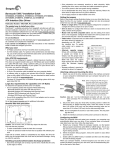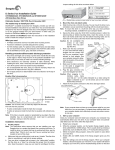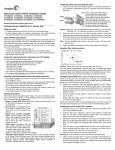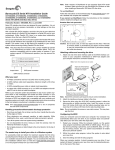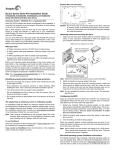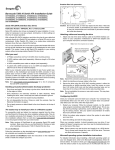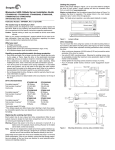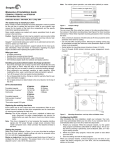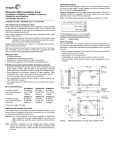Download Seagate ST3200826A Installation guide
Transcript
Barracuda 7200.8 Installation Guide ST3400832A, ST3300831A, ST3250823A, and ST3200826A ATA Interface Disc Drives Publication Number: 100325406, Rev. A, November 2004 The easiest way to install your drive DiscWizardTM, available exclusively from Seagate®, provides you with customized installation instructions for your hard drive. You can get this free disc drive installation software from our web site at www.seagate.com/support or run the program directly from your web browser. In either case, you should run DiscWizard before you install your drive. To run DiscWizard: Follow the instructions on the download page at www.seagate.com to create a diskette and complete the installation. If you cannot run DiscWizard, follow the instructions on this installation sheet to install and configure your drive. What you need • A Phillips screwdriver and four 6-32 UNC drive mounting screws • An ATA interface cable. For optimum performance use an 80-conductor Ultra ATA/100 cable which has blue, gray, and black connectors. Ultra ATA/100 requirements The drive can be configured to support a default maximum transfer rate. This drive can support transfer rates up to 100 Mbytes per second (UDMA 5) in Ultra ATA/100 mode. Using a software utility, you can set the default transfer rate to the best capability of your system. For your drive to run in this mode, you need the following: • A computer that supports UDMA mode 5 • A 40-pin, 80-conductor cable (available from your computer dealer) • A software utility to confirm and activate Ultra ATA/100. Seagate provides a utility called UATA100.exe. You can download the latest version from our web site at www.seagate.com. • Windows XP, Windows Me, or Windows 98 operating system which supports Ultra ATA 100. • Drive electronics are extremely sensitive to static electricity. While installing the drive, wear a wrist strap and cable connected to ground. • Turn off the power to the host system during installation. • Do not disassemble the drive; doing so voids the warranty. Return the entire drive for depot service if any part is defective. • Do not apply pressure or attach labels to the drive. Setting the jumpers Refer to the jumper settings illustration below or on your drive label to configure the drive for your system. Jumper settings can also be accessed online from our web site at www.seagate.com. • Master or single drive: The drive is shipped configured for a master or a single drive with a jumper set on pins 7 and 8. • Drive is slave: To configure the drive as a slave or second drive on the cable, remove all the jumpers. • Master with non-ATA compatible slave: Use this setting if the slave drive is not recognized. Configure the master drive with a jumper set on pins 5 and 6 and pins 7 and 8 to enable this option. • Cable select: Computers that use cable select to determine the master and slave drives by selecting or deselecting pin 28, CSEL, on the interface bus. To enable cable select, set a Options jumper block jumper on pins 5 and 6. *Master or single drive • Alternate capacity jumper: Drives Drive is slave with a 40-Gbyte capacity or greater Master with non ATAcompatible slave are limited to 32 Gbytes. Use this *Cable select jumper only if you have a legacy sysAlternate capacity. tem with a BIOS that does not support Limits drive capacity large capacity disc drives. When using to 32 Gbytes 7 5 3 1 the alternate capacity jumper, • Manager software is required to achieve the drive’s full capacity. 8 6 4 2 Attaching cables and mounting the drive 1. Attach one end of the drive interface cable to the interface connector on your computer’s motherboard (see your computer manual for connector locations). Caution. Align pin 1 on the motherboard connector with pin 1 on your Large disc requirements (for capacities over 137 Bytes) To realize the full capacity of drives over 137 Gbytes: • Use an operating system that supports 48-bit addressing: - Microsoft Windows XP Home with Service Pack 1 - Microsoft Windows XP Professional with Service Pack 1 - Windows 2000 Professional with Service Pack 3 - Windows 2000 Server with Service Pack 3 • Use a 48-bit compatible Ultra ATA/133 PCI host adapter card or connector on your motherboard. • Go to http://support.seagate.com for additional information. Breather filter hole precaution Master Pin 1 Slave Note. When configuring two ATA devices on the same cable, both must use Cable Select or both must use Master/Slave jumper settings. If using a standard 40-pin cable, the master and slave Co m Mo pu drives can be placed in any position. If the ter rbo ard using a 40-pin 80-conductor cable, attach the blue connector to the motherboard, the black connector to the master drive and the grey connector to the slave. drive connector. Pin 1 is marked by a stripe on one side of the cable. 2. Secure the drive using four 6-32 UNC mounting screws in either the side-mounting or bottom-mounting holes. Insert the screws no more than 0.20 inches (5.08 mm) into the bottom-mounting holes and no more than 0.14 inches (3.55 mm) into the side-mounting holes. Note. Do not overtighten the screws or use metric screws. This may damage the drive. 3. Attach the interface connector and the power connector to the drive. Configuring the BIOS Caution. Do not cover, seal, or insert any object into this hole. This hole has two purposes: • To allow condensation inside the hard disc to escape • To allow air pressure inside the hard disc to equalize with ambient pressure If this hole is covered, sealed, or penetrated by any object, the drive reliability may be compromised and could lead to permanent damage—doing so voids the warranty. Handling precautions/electrostatic discharge protection • Disc drives are fragile. Do not drop or jar the drive. Handle the drive only by the edges or frame. Close your computer case and restart your computer. your computer may automatically detect your new drive. If your computer does not automatically detect your new drive, follow the steps below. a. Restart your computer. While the computer restarts, run the System Setup program (sometimes called BIOS or CMOS setup). This is usually done by pressing a special key, such as DELETE, ESC, or F1 during the startup process. b. Within the System Setup program, instruct the system to auto detect your new drive. c. Enable LBA and UDMA modes, if available and then save the settings and exit the Setup program. When your computer restarts, it should recognize your new drive. If your system still doesn’t recognize your new drive, see the troubleshooting section on the back of this sheet. BIOS Settings Drive Model Formatted Gbytes ST3400832A 400.0 ST3300831A 300.0 ST3250823A 250.0 ST3200826A 200.0 *One sector equals 512 bytes. Total Sectors* 781,422,768 586,072,368 488,397,168 390,721,968 Cache 8 Mbytes 8 Mbytes 8 Mbytes 8 Mbytes Preparing the drive using DiscWizard Installing a single drive If you are installing a single drive, we recommend using DiscWizard to automatically partition and format your drive. DiscWizard software is available at www.seagate.com and is free. During the download, the Diskette Creator creates a portable bootable diskette. To run DiscWizard: 1. Insert your bootable DiscWizard diskette and follow the instructions. DiscWizard will guide you through the installation process. 2. Boot your computer from the Windows operating system CD-ROM or from your system startup diskette with the Windows CD loaded. At the prompt, type setup. Follow the instructions provided on your screen. Installing a slave drive If you are installing a second drive, or slave, to your system, use the DiscWizard software available at www.seagate.com. If you do not want to install your drive using either DiscWizard or Disk Manager, see “Standard Microsoft Installation” below to partition and format your drive. Standard Microsoft installation Caution. Partitioning or formatting a drive erases all data on the drive. Seagate assumes no liability if you erase your data. 1. Insert a bootable Windows startup diskette and restart your computer. This is provided with your Microsoft Windows operating system software. 2. Run fdisk and create a primary DOS partition. 3. Mark the partition as active to make the partition bootable. Drive formatting Caution. Use the correct drive letters to prevent formatting a drive that already contains data. 1. At the A: prompt, type format x: (where x is the letter of your first new partition) and then press the Enter key. Repeat the format process for all new partitions. 2. Proceed to “Loading the operating system” below. Loading the operating system Note. The operating system needs to be installed on the master drive only. It is not required when adding a second drive. 1. Boot your computer from your Windows operating system CD-ROM or from your system startup diskette with the Windows CD loaded in the CD drive. 2. At the prompt, type setup and continue with the Windows setup as instructed on your screen. Troubleshooting If your drive is not working properly, these troubleshooting tips may help solve the problem. 1. Does the drive spin up? A spinning drive produces a faint whine and clicking noise that begins when power is applied. If your drive does not spin, check that the power connector and interface cable are securely attached and the jumpers are installed correctly. 2. Does the computer recognize the drive? Verify that the drive is enabled in the system CMOS or setup program. If not, select the autodetect option and enable it. If your drive has a problem, it may not be recognized by the system. 3. Does FDISK detect the drive? Run the FDISK program located on your Windows startup diskette. Type fdisk/status to verify that your hard drive is present and recognized by the system. 6. Why does my computer hang on startup? Verify that your system is ATA/100 compatible with the UDMA mode setting. Some legacy BIOS cause hangs on startup or other problems if it is not ATA/100 compatible. For more information, see the earlier section on the Ultra ATA/100 requirements. In addition, some legacy BIOS may cause a hang due to the large drive capacity. Consider using the alternate capacity jumper if it is available on your drive model. Use the alternate capacity jumper if your computer does not support higher capacity drives. The jumper will limit large capacity drives to 32 Gbytes. Note. If these tips do not answer your question or solve the problem, contact your dealer or visit http://seatools.seagate.com to download SeaTools disc diagnostics software and more troubleshooting advice. Seagate support services For online information about Seagate products, visit www.seagate.com or e-mail your disc questions to [email protected]. If you need help installing your drive, consult your dealer first. If you need additional help, call a Seagate technical support specialist. Before calling, note your system configuration and drive model number. Africa Australia Austria Belgium China* Denmark France Germany Hong Kong Hong Kong* 0032165 India Indonesia Ireland Italy Malaysia Middle East +1-405-324-4714 1800-14-7201 0 800-20 12 90 00 800-47324283 800-810-9668 00 800-47324283 00 800-47324283 00 800-47324283 800-90-0474 001-800-0830-1730 Netherlands New Zealand Norway Poland Spain Sweden Switzerland Singapore Taiwan* Thailand 00 800-47324283 0800-443988 00 800-47324283 00 800-311 12 38 00 800-47324283 00 800-47324283 00 800-47324283 800-1101-150 00-800-0830-1730 001-800-11- 1-600-33-1104 001-803-1-003-2165 00 800-47324283 00 800-47324283 1-800-80-2335 +1-405-324-4714 Turkey United Kingdom USA/Canada/ Latin America Other European countries 00 800-31 92 91 40 00 800-47324283 1-800 SEAGATE or +1-405-324-4700 +1-405-324-4714 *Chinese Warranty. To determine the warranty status of your Seagate disc drive, contact your place of purchase or visit our web site at www.seagate.com for more information. Return Merchandise Authorization (RMA). Run SeaTools to diagnose your drive before requesting a return authorization. In addition, please verify that your drive is defective by following the troubleshooting checklist in this guide. Seagate offers comprehensive customer support for all Seagate drives worldwide. Seagate customer service centers are the only facilities authorized to service Seagate drives. Drive return procedures vary depending on geographical location and are subject to current international trade regulations. Shipping the drive Caution. Back up the data before shipping. Seagate assumes no responsibility for data lost during shipping or service. Shipping drive in an unapproved container voids the warranty. Pack the drive with original box and packing materials. Use no other materials. This prevents electrical and physical damage in transit. Electromagnetic compliance for the European Union. This model complies with the European Union requirements of the Electromagnetic Compatibility Directive 89/ 336/EEC of 03 May 1989 as amended by Directive 92/31/EEC of 28 April 1992 and Directive 93/68/EEC of 22 July 1993. Compliance of this drive, as a system component, was confirmed with a test system. We cannot guarantee that your system will comply. The drive is not meant for external use (without properly designed enclosure, shielded I/O cable, etc.). Sicherheitsanleitung 1. Das Gerrät ist ein Einbaugerät, das für eine maximale Umgebungstempeatur von 60°C vorgesehen ist. 2. Zur Befestigung des Lufwerks werden 4 Schrauben 6-32 UNC-2A benötigt. Bei seitlicher Befestigung darf die maximale Länge der Schrauben im Chassis nicht merh als 3,3 mm und bei Befestigung an der Unterseite nicht mehr als 5,08 mm betragen. 3. Als Versorgungsspannugen werden benötigt: +5V +/- 5% 1,2A; +12V +/- 5% 2,0A 4. Die Versorgungsspannung muss SELV entsprechen. 5. Alle Arbeiten auf dem Festplattte dürfen nur von Ausgebiletem Serciepersonal durchgeführt werden. Bitte entfernen Sie nicht die Aufschriftenschilder des Laufwerkes. 6. Der Einbau des Laufwerkes muss den Anforderungen gemäss DIN IEC 950 VDE 0805/05.90 entspreche. 4. Does Scandisk find the drive defect-free? Scandisk is a utility located on your Windows startup diskette that scans the drive for defects. If defects are detected, this may be an indication of a problem. 5. Why won’t the drive format to full capacity? Verify that your BIOS has autodetect and LBA mode enabled. Otherwise, you may need to use Disk Manager to achieve the full capacity of your drive. Download the latest version from www.seagate.com or find it on your CD. © 2004 Seagate Technology LLC. All rights reserved Publication number: 100325406, Rev. A, November 2004, Printed in USA Seagate, Seagate Technology, and the Seagate logo are either registered trademarks or trademarks of Seagate Technology LLC. Barracuda is a registered trademark of Seagate Technology LLC. Other product names are registered trademarks or trademarks of their owners. Seagate reserves the right to change, without notice, product offerings or specifications.


